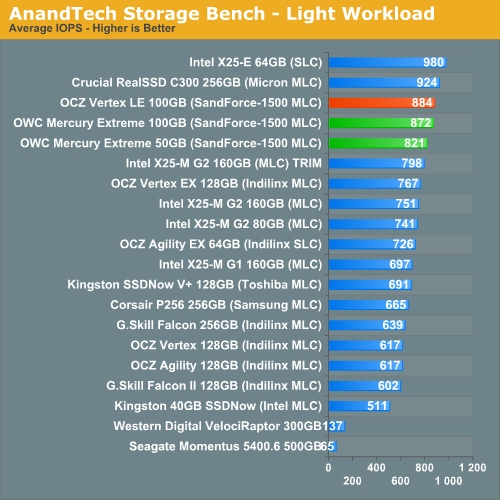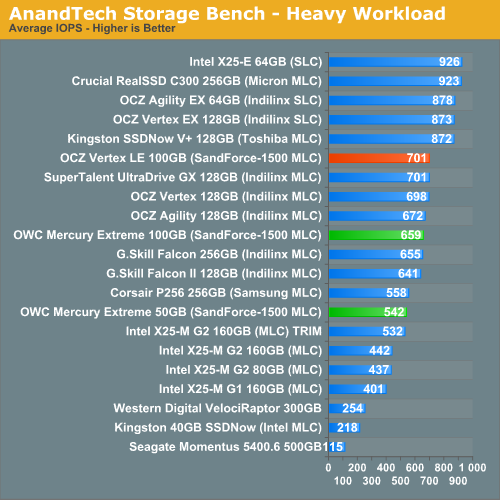OWC Mercury Extreme SSD - First Look at a 50GB SandForce Drive
by Anand Lal Shimpi on February 26, 2010 12:00 AM EST- Posted in
- Storage
AnandTech Storage Bench
Note that our 6Gbps controller driver isn't supported by our custom storage bench here, so the C300 results are only offered in 3Gbps mode.
The first in our benchmark suite is a light usage case. The Windows 7 system is loaded with Firefox, Office 2007 and Adobe Reader among other applications. With Firefox we browse web pages like Facebook, AnandTech, Digg and other sites. Outlook is also running and we use it to check emails, create and send a message with a PDF attachment. Adobe Reader is used to view some PDFs. Excel 2007 is used to create a spreadsheet, graphs and save the document. The same goes for Word 2007. We open and step through a presentation in PowerPoint 2007 received as an email attachment before saving it to the desktop. Finally we watch a bit of a Firefly episode in Windows Media Player 11.
There’s some level of multitasking going on here but it’s not unreasonable by any means. Generally the application tasks proceed linearly, with the exception of things like web browsing which may happen in between one of the other tasks.
The recording is played back on all of our drives here today. Remember that we’re isolating disk performance, all we’re doing is playing back every single disk access that happened in that ~5 minute period of usage. The light workload is composed of 37,501 reads and 20,268 writes. Over 30% of the IOs are 4KB, 11% are 16KB, 22% are 32KB and approximately 13% are 64KB in size. Less than 30% of the operations are absolutely sequential in nature. Average queue depth is 6.09 IOs.
The performance results are reported in average I/O Operations per Second (IOPS):

In our light workload we see a small performance drop from the 100GB to 50GB capacity point. It's nothing tremendous though and definitely not noticeable in real world usage. Other than the usual performance degradation issues you see with running an SSD close to max capacity, you shouldn't really see any difference in performance between a 50GB or a 100GB SandForce drive.
If there’s a light usage case there’s bound to be a heavy one. In this test we have Microsoft Security Essentials running in the background with real time virus scanning enabled. We also perform a quick scan in the middle of the test. Firefox, Outlook, Excel, Word and Powerpoint are all used the same as they were in the light test. We add Photoshop CS4 to the mix, opening a bunch of 12MP images, editing them, then saving them as highly compressed JPGs for web publishing. Windows 7’s picture viewer is used to view a bunch of pictures on the hard drive. We use 7-zip to create and extract .7z archives. Downloading is also prominently featured in our heavy test; we download large files from the Internet during portions of the benchmark, as well as use uTorrent to grab a couple of torrents. Some of the applications in use are installed during the benchmark, Windows updates are also installed. Towards the end of the test we launch World of Warcraft, play for a few minutes, then delete the folder. This test also takes into account all of the disk accesses that happen while the OS is booting.
The benchmark is 22 minutes long and it consists of 128,895 read operations and 72,411 write operations. Roughly 44% of all IOs were sequential. Approximately 30% of all accesses were 4KB in size, 12% were 16KB in size, 14% were 32KB and 20% were 64KB. Average queue depth was 3.59.

Crank up the IOPS and our 50GB drive stops doing so well. I should point out that despite its fall from grace, the 50GB OWC drive is still as fast as the 160GB Intel X25-M G2. While there's indeed a drop in random write speed, it doesn't appear to be a crippling drop.
Our final test focuses on actual gameplay in four 3D games: World of Warcraft, Batman: Arkham Asylum, FarCry 2 and Risen, in that order. The games are launched and played, altogether for a total of just under 30 minutes. The benchmark measures game load time, level load time, disk accesses from save games and normal data streaming during gameplay.
The gaming workload is made up of 75,206 read operations and only 4,592 write operations. Only 20% of the accesses are 4KB in size, nearly 40% are 64KB and 20% are 32KB. A whopping 69% of the IOs are sequential, meaning this is predominantly a sequential read benchmark. The average queue depth is 7.76 IOs.

We've already shown that read speeds are no lower with the 50GB drive, and thus our gaming workload which involves mostly texture/level loads off of the SSD shows no difference between the various capacity points of SandForce drives. We're still very bottlenecked by 3Gbps SATA here.










74 Comments
View All Comments
SeanFowler - Friday, February 26, 2010 - link
You mention the performance that's lost on the 50GB platform, which is interesting.As an SSD noob I wasn't aware that performance on smaller drives could be significantly slower than the performance on larger drives of the same series.
I had the 100GB LE on order, then cancelled it to order the C300 as I have Sata3, then found out that the 128GB C300 drive has mediocre write speeds (up to 140MB/s). Talk about a mess!
I see that you and most other sites tend to focus on the largest drives in a series, typically 256GB. Are these really the drives most of your readers are buying though? Based on your LE review and SSD round-up I went for the C300. I can't help thinking that your recommendations would have been very different had you instead tested the 128GB drives. Btw there's more info about the slow write speeds in my comment on the LE article, left earlier today.
I'm now in a bit of a quandry. Do I try to get an LE after all? Will it also have significantly poorer write performance than the 256GB version that everyone's reviewing? Help me Anand Kenobi; you're my only hope!
greenguy - Saturday, February 27, 2010 - link
I bought 3 of the Intel x25-V 40GB drives recently - two for a workstation (mirrored boot drive), and one for my home system. I think that most people who run operating systems other than MS (e.g. Linux, BSD, OpenSolaris) would only really need around the 40-50GB mark. When I look at my Linux system that has been running over a year, the OS and apps part of the drive (i.e. that which benefits from an SSD), it doesn't come anywhere near the 40GB mark.Everything else is media, and even Samsung's 5200RPM HDD is faster than these really need to be. 80MB/s and Bluray's max speed is 7MB/s. As a media drive, most of these will be used write once, read many, and for a read speed of 7MB/s, that's only 500rpm.
Only gamers are going to benefit from larger SSDs, and that's only if they can't be bothered in copying saved game files and settings to the storage drive after deleting whatever games they have gotten sick of. Or simply moving the directory to the storage drive and moving it back when done.
When prices come down again, you can buy more and raid them. This will give nearly double the speed for equivalent cost of buying say, an 80GB drive.
Really, $/GB is a pretty poor metric when evaluating these drives for use as a boot drive. Random 4k read speed/$ is probably the best, with one eye on the random writes (so long as the drive is bigger than say, $30GB).
Of course, this is not the case for laptop drives unless you can fit both a boot and a storage drive in them.
Anand Lal Shimpi - Friday, February 26, 2010 - link
I usually try to review the sweetspot drive, Micron sent out only 256GB drives for review but normally I focus on the ~120GB drives. The LE I tested was a 100GB drive, so you can see where your performance would have been. I'll request a 128GB drive from Crucial right away :)SeanFowler - Friday, February 26, 2010 - link
Thanks Anand; I was forgetting you'd reviewed the 100GB LE rather than the 200GB version. This is probably the one for me to go for then.Another interesting subject is what impact read and write speeds have on the perceived performance of an OS drive. I would expect the read speed to be more important than the write speed as OS drives do more reads than writes.
This could mean that the extra 70MB/s read speed the C300 gives over the LE compensates for the 110MB/s deficit in write speeds.
I could cancel the C300 order and wait to see what's what in a week or so, but by that time the LE's will probably have sold out. The safest option right now seems to be the LE.
Crypticone - Friday, February 26, 2010 - link
I too am not sure what drive to purchase right now. I would really like to see the performance of the C300 in SATA 6gig mode on the Storage Bench. Any chance of running this test? I am interested to see if the faster interface would improve apps and games loading, etc in the real world.Anand Lal Shimpi - Friday, February 26, 2010 - link
6Gbps SATA will only improve large file read performance off of the drive. Loading apps and games shouldn't be any faster. Nearly all high performance SSDs load a single app/game in about the same time.vol7ron - Saturday, February 27, 2010 - link
That might be true presently, but shouldn't that change as apps/games take advantage of more cores while loading and executing?vol7ron
pesos - Friday, February 26, 2010 - link
Very cool! Any plans to let the IT side guys take a crack at these in RAID configurations and let them lose on some database benchmarks?pesos - Friday, February 26, 2010 - link
I meant let them LOOSE of course - they probably wouldn't loseviewwin - Friday, February 26, 2010 - link
When will we hear more about the consumer level controller, SF-1200?